Ophrys insectifera - Fly Orchid
Phylum: Magnoliophyta - Class: Liliopsida - Order: Orchidales - Family: Orchidaceae
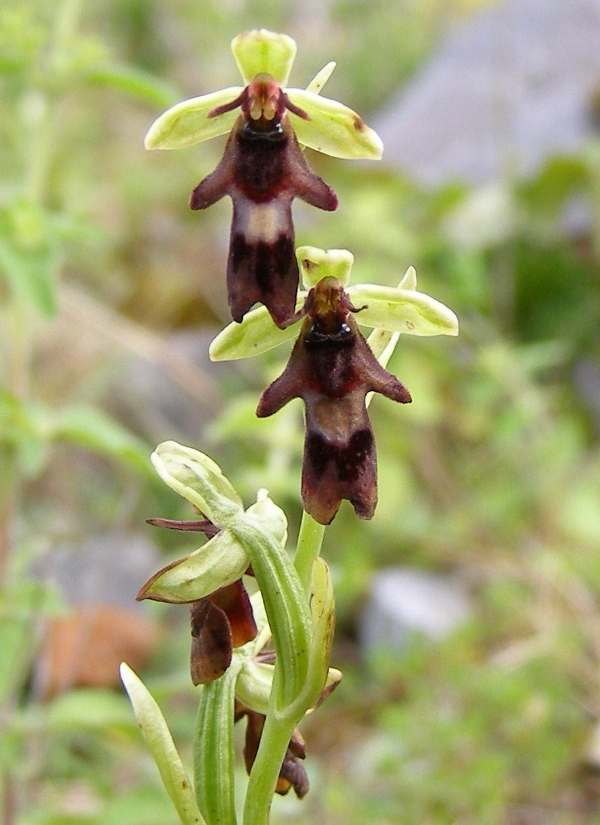
The Fly Orchid can never be described as pretty, but it is one of the most bewitching of the Ophrys species displaying, as it does so perfectly, the highly evolved deception mechanisms that the genus of bee orchids uses to attract pollinating insects.The part of the flower which demonstrates most visibly the results of this evolutionary process is the lip which can be velvety or hairy with a speculum (mirror) in the centre that is hairless and shiny and looks just like the wings of the insects that it hopes to attract.
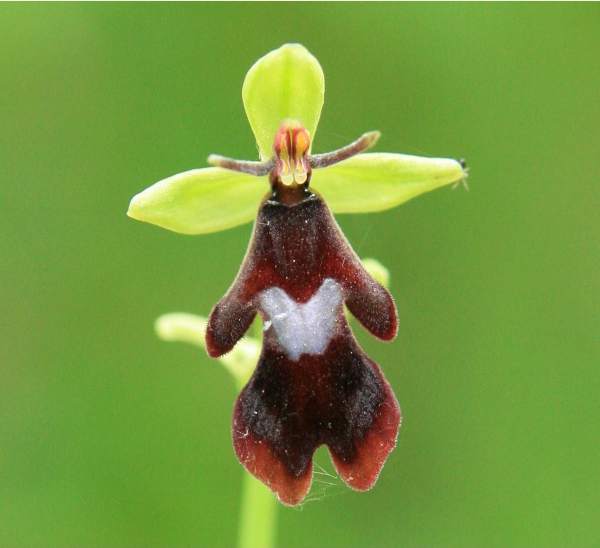
The specimen shown above was photographed in the Burren, County Clare, Ireland in mid-June.
Description
Ophrys insectifera is so distinctive that it is very easy to identify. The flowers closely resemble little flies - the lip forms the body of the insect, the mirror is shiny like the folded wings of a fly and there are even two glossy depressions at the base of the lip which represent the insect's eyes.
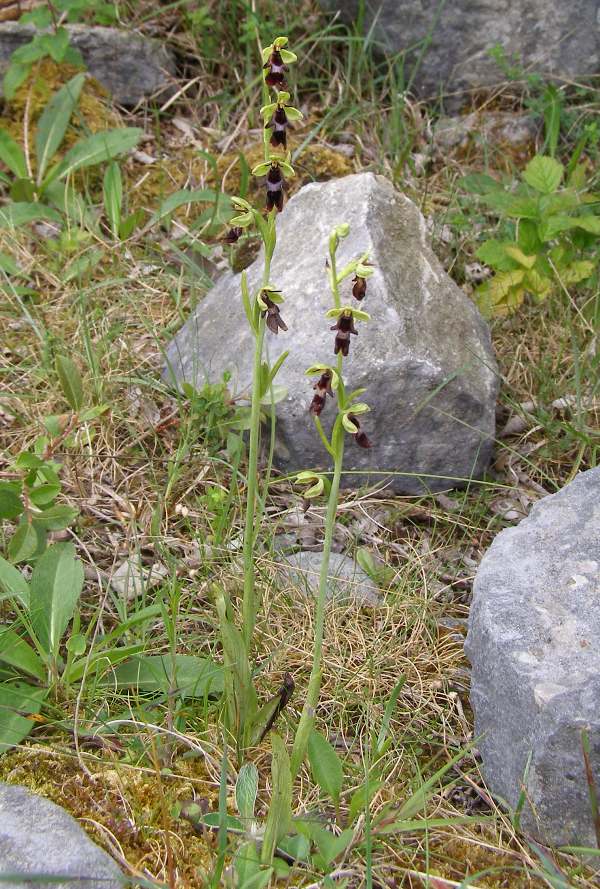
Fly Orchid plants can grow quite tall - up to 60cm is not uncommon. The plant is spindly and has a lax inforescence which carries up to 15 flowers. Fly Orchids often form colonies of up to 10 plants, but despite this they remain difficult to find because the drab colouring blends in so well with the surrounding grass and other plants.
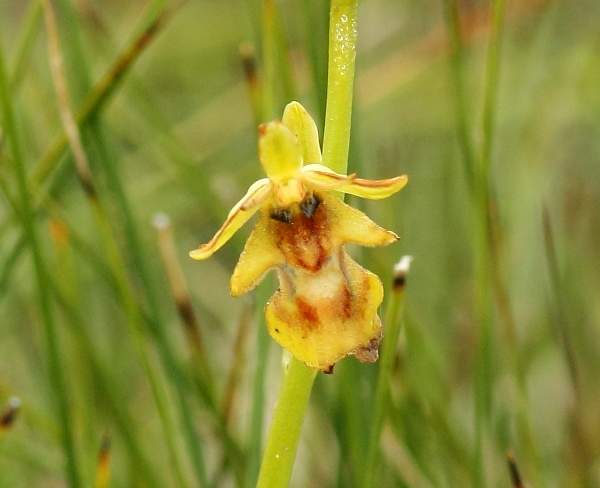
Ophrys insectifera f. luteomarginata, the rare yellow form of the Fly Orchid in the Anglesey Fens, North Wales
Distribution
The Fly Orchid is a European plant which can be found as far south as Spain and Greece but, unlike other members of the genus, extends it range into the north as far as Scandinavia, Finland and the Baltic States.
It is rare in the UK and Ireland and is restricted to a few places in the southern parts of England, Wales and Ireland. It is also found in many European countries.
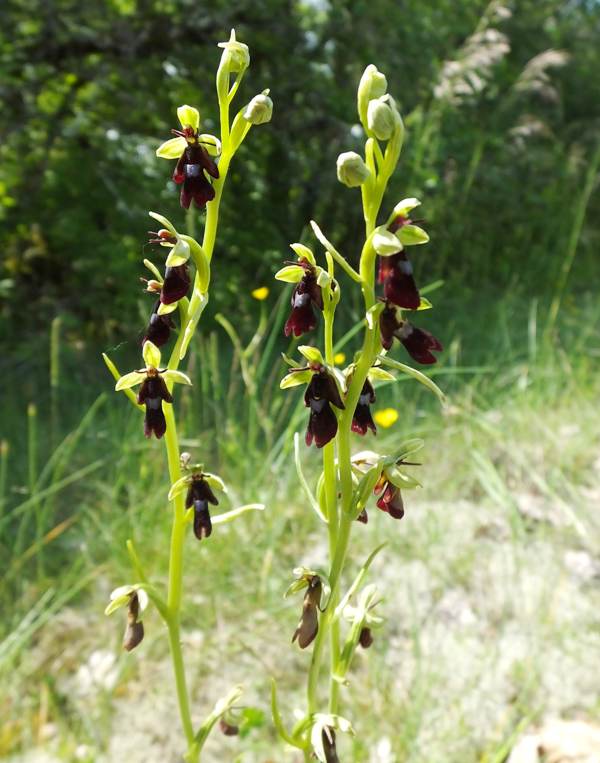
Above: a splendid group of Fly Orchids in roadside scrubland, southern France
Habitat
Ophrys insectifera is tolerant of a wide range of habitats and grows in stony grassland, on roadside verges and on the edges of open woodland. It also grows on the limestone pavements turloughs (seasonal lakes) of The Burren in Ireland and Lancashire in northern England. In Wales the Fly Orchid grows in the Anglesey Fens, where it benefits from the alkaline flushes of water running into the marshy ground.
Flowering times
In the UK and Ireland, the Fly Orchid flowers in the first half of June, whereas in southern France you can see these remarkable orchids as early as April.
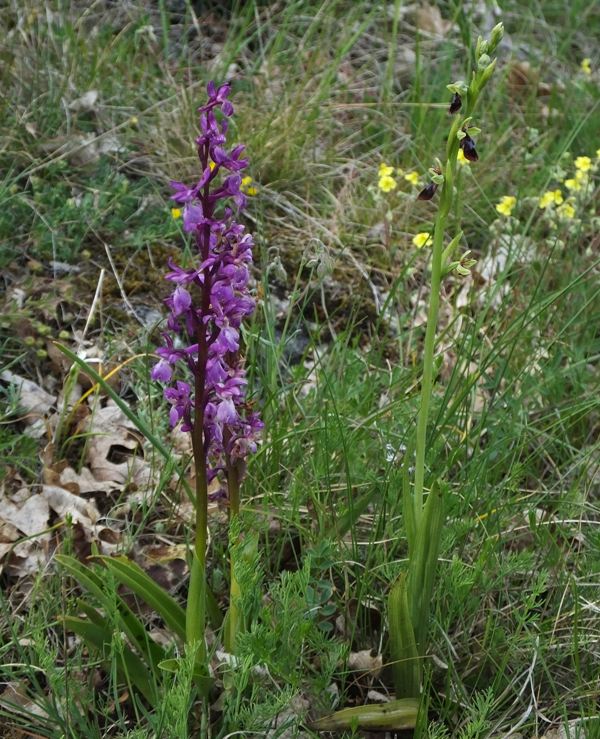
Above: Fly Orchid and Early-purple Orchid flowering together in mid May on a roadside verge in the Aveyron region of southern France.
Varieties and Hybrids
There are no subspecies, but there are a number of varieties:
Ophrys insectifera var. ochroleuca has a greenish-yellow lip with a white speculum and has been reported from Kent, Wiltshire and Hampshire.
Ophrys insectifera var. flavescens has a yellowish-brown lip and a blue or white speculum; it is reported from Gloucestershire.
Ophrys insectifera var. subbombifera has a very broad central lobe and is reported from Surrey and Hampshire.
Ophrys insectifera var. parviflora has much smaller flowers than is usual.
Ophrys insectifera var. luteomarginata has a central lobe with a broad yellow margin and is reported from Surrey, Hampshire, Gloucestershire and Anglesey.
Hybrids
Two hybrids are recorded:
Ophrys x pietzschii is a hybrid with the Bee Orchid Ophrys apifera,
Ophrys x hybrida is a hybrid with the Early Spider-orchid Ophrys sphegodes.
Etymology
The genus name Ophrys comes from Greek and means 'eyebrow' - a reference to the hairy fringe of the lip of the flower of many orchids in this genus. The specific epithet insectifera comes from Latin and means 'bearing insects' - a reference to the insect-like appearance of the flowers.
Reference sources
The Plant List
Sue Parker (2023) Wild Orchids of Wales - how, when and where to find them; First Nature e-book (Amazon Kindle format)
Henrik AErenlund Pedersen & Niels Faurholdt (2007) Ophrys - The Bee Orchids of Europe; Kew
Anne and Simon Harrap (2005) Orchids of Britain and Ireland; A&C Black
Pierre Delforge (2005) Orchids of Europe, North Africa and the Middle East; A&C Black
Den Nordiska Floran (1992) Bo Mossberg, Stefan Ericsson and Lennart Stenberg; Wahlstrom & Widstrand
Please Help Us: If you have found this information interesting and useful, please consider helping to keep First Nature online by making a small donation towards the web hosting and internet costs.
Any donations over and above the essential running costs will help support the conservation work of Plantlife, the Rivers Trust and charitable botanic gardens - as do author royalties and publisher proceeds from books by Pat and Sue.


